Water Stinson
Though the Stinsons of the late ’40s weren’t designed as floatplanes, they adapt to water as if born for it
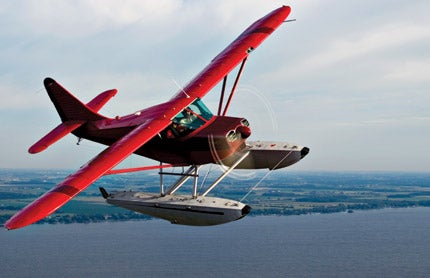 |
Lake Winnebago isn't agreeable today, as we splash out from the Oshkosh Seaplane Base. The wind blows us sideways as we leave the shelter of the harbor and head out onto the lake. For one weekend every July, this small boat harbor, five miles southeast of Oshkosh, Wis., turns into one of the busiest seaplane bases in America. Today, the lake will limit water flying to a few brave souls.
Ross Benike is one of those. His bright-red 1948 Stinson Station Wagon 108-3 on Edo floats pitches on the waves, the water sometimes washing over the bow of the floats. His is the only seaplane flying this morning, but Benike is confident his Super Stinson is the equal of Lake Winnebago.
He's right. With help from a 230 hp Continental O-470 spinning a huge 88-inch McCauley prop, the Stinson leaps up onto the step, jumps off the water after a short run and climbs smoothly into the bright Wisconsin morning. Benike comments that back in 2002, the lake was so rough that the seaplane base manager had to open the lagoon for takeoffs so pilots could get home.
Predictably, the air a few hundred feet above the lake is less troubled than the water. I form up on photographer Jim Lawrence in a land-based Skyhawk out of nearby Fond du Lac, and we begin to fly our perpetual circles for the air-to-air pictures you see in this article. To my surprise, this Stinson, made large with the addition of floats, handles very well, carving its way through the turns and holding position on the Hawk effortlessly. It's almost as if the airplane doesn't know it's hauling two large, heavy, aluminum pontoons through the air. Lawrence comments on the radio, "What a beautiful airplane."
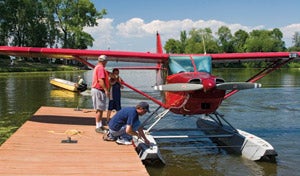 |
Though I'm on the receiving end of the photos, I'm sure it is. In some respects, a Super Stinson on floats makes perfect sense. The basic Station Wagon seems almost ideally adapted for the water mission. The airplane is blessed with a generous cabin and a king-sized rudder, especially important for directional control in the wet. The conversion from the stock airplane's 165 hp Franklin to 230 hp Continental makes it easier to overcome suction and unstick from liquid runways.
The big McCauley prop is a major factor in getting off short water. Because of its huge diameter, the 88-inch tractor is approved only for floatplanes, and though Benike loves the performance, he's still a little on the fence about the cost versus the benefits. He says there's no question the airplane leaps off quicker, as much as five seconds faster than before, but he's concerned about the problem of tip erosion. In any rough-water takeoff, the tips take a beating, and over time, the erosion could be a significant maintenance problem, forcing more-frequent blade replacement. During my flight, we saw the tip shredding water as the airplane came up on the step, but we couldn't detect any erosion later.
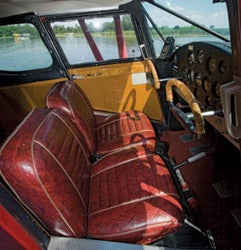 |
Good water manners and quick liftoff are key talents for floatplanes. Seaplane pilots don't care much about cruise speed. The primary benefit of more horsepower on the water is in leaving it, but extra power also increases fuel burn, a more critical concern in an airplane that can't refuel just anywhere. It's important to remember that refueling sites for pure seaplanes may be more widely separated than for landplanes. Except perhaps in Minnesota.
Benike lives in Birchdale, hard by the Canadian border in the "Land of 10,000 Lakes," a seaplane paradise. In this part of the world, it's not necessary to mount those large, heavy, more-complex amphibious floats, as there are docks and avgas refueling sites in hundreds of locations. Even when fuel isn't readily available, many older-generation seaplanes are approved for auto/boat gas, and you can park them on any convenient lake or sheltered river.
Accordingly, Benike keeps his airplane on the Rainy River about a mile from his home, a 700-acre farm planted with wheat, canola and soy beans. The river itself forms the international border between northern Minnesota and Canada, so Benike often does his flying in Ontario, fishing or simply exploring the beautiful country up north.
"A pure floatplane might seem like a liability in some places," says Benike, "but here in Minnesota, you give away very little in exchange for the fun of operating off water. There are lakes adjacent to practically anywhere you might want to fly; even if there's no established seaplane base, there are few restrictions on waterbird operations. If you fly someplace where there's no avgas, you can nearly always arrange for auto fuel if you have to use it."
Total capacity in the Station Wagon is 50 gallons or 300 pounds, and at a burn of 12.5 gph, Benike figures his longest legs at 3.5 hours. "I never press my luck on range," he comments, "but it's nice to know that if you did have any kind of engine problem in my part of the world, you have emergency landing sites practically everywhere below. You can glide down and land on virtually any convenient 1,000-foot stretch of water, even less if there's a headwind."
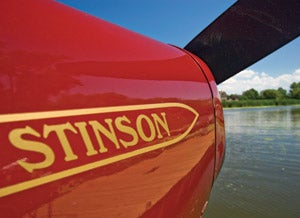 Ross Benike purchased his 1948 Stinson 108-3 with wheels, floats and skis at the bargain price of $52,000 in 1997. |
Fuel management takes on a special significance when there's less petrol available, and for that reason, Benike installed a JPI EDM-700 engine analyzer with a fuel computer. "The JPI is a lifesaver for a seaplane pilot. It not only allows me to keep track of EGTs, CHTs, oil temp and all the other parameters, but also lets me monitor fuel burn right down to a tenth of a gallon, so I know exactly how much I have left at any time," he explains.
When the airplane is docked at Benike's informal base in Birchdale, the owner refuels it from a storage tank in his truck. He also has a 500-gallon tank at his farm adjacent to his 2,200-foot grass strip. He operates the Stinson about equal time on wheels, skis and floats, flying perhaps 100 hours a year.
Benike likes to cruise his Stinson at 23 square most of the time, operating at about 75% power and at 6,500 feet or higher. He sees cruise speeds of 105 to 110 knots. Typical of most floatplane pilots, he's more interested in how much he can carry and where he can go rather than how fast he can get there. That's partially because flying over the magnificent lake country of the northern Midwest invites sightseeing.
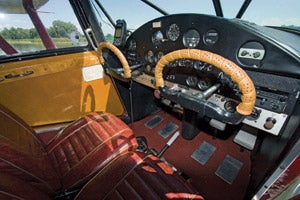 Benike's Stinson has a generous-sized cabin, a large rudder and a 230 hp Continental engine (converted from a 165 hp Franklin). |
With the conversion to floats, the Station Wagon picks up an extra 100 pounds of gross, partially offsetting the 300-pound empty-weight increase of the floats. "With full fuel, I'm left with about 500 pounds of payload," Benike comments. "That means I can carry three lightweight people or two folks and all the fishing gear they can get aboard. I really like the Stinson's manners on water, and it will handle most conditions that I'm liable to encounter." Swells on the day of our flight were running probably a foot, and Benike says that's about the operational limit. Any higher swells are liable to beat up the floats and put major stress on the airplane. "Lake Winnebago is often a problem for seaplanes, primarily because it's so shallow, about 16 feet at its deepest point," says Benike. "This can transmit plenty of energy to the surface and, in combination with a little wind, make takeoffs and landings a problem. There are even several places on the north side where sandbars are broaching the surface."
Benike bought the Station Wagon in 1997 as a total package with wheels, floats and skis for $52,000. "That seemed like a steal at the time, as the Edo 2425 floats alone cost about $10,000. With the big engine and a choice of three modes of undercarriage, the Stinson is a remarkably talented machine capable of going just about anywhere. Wheels and floats provide ready access in summer, and skis allow operation to many of the same frozen rivers and lakes in winter.
"When I'm flying on wheels, the takeoff performance is practically STOL," claims Benike, "so I can get into virtually any strip I can find, real or imaginary. The 108-3 is actually a good off-airport airplane, and many of the type are used in the backcountry of Canada and Alaska as bush birds."
The pilot knows a little about bush flying. In addition to his experience in the Stinson, he purchased a Maule M4-220C in 1991 and used it as his trainer. "That probably wasn't the ideal airplane for primary training," Benike admits, "but I really learned a lot about taildraggers and off-airport operations with the Maule."
Benike can convert his Stinson back and forth from wheels to floats in a long afternoon, partially because he's done it so many times before. With the help of one other person to control the hoist, he can manhandle the airplane on or off floats in about four hours.
However Ross Benike's airplane is configured, he's dedicated to hopping rides with aspiring young pilots, and he's an especially active participant in the EAA's Young Eagles Program (www.youngeagles.org). So far, he's given just over 200 rides to America's future pilots.
"It's usually a little more fun for them on skis or floats," Benike explains, "but it's gratifying to see their enthusiasm in the sky, no matter what the undercarriage. They all seem to love the thrill of flying nearly as much as I do."
The Stinson 108 is one of the best deals on the used market. Check out some of the otherCheapest Planes In The Sky.

Subscribe to Our Newsletter
Get the latest Plane & Pilot Magazine stories delivered directly to your inbox




